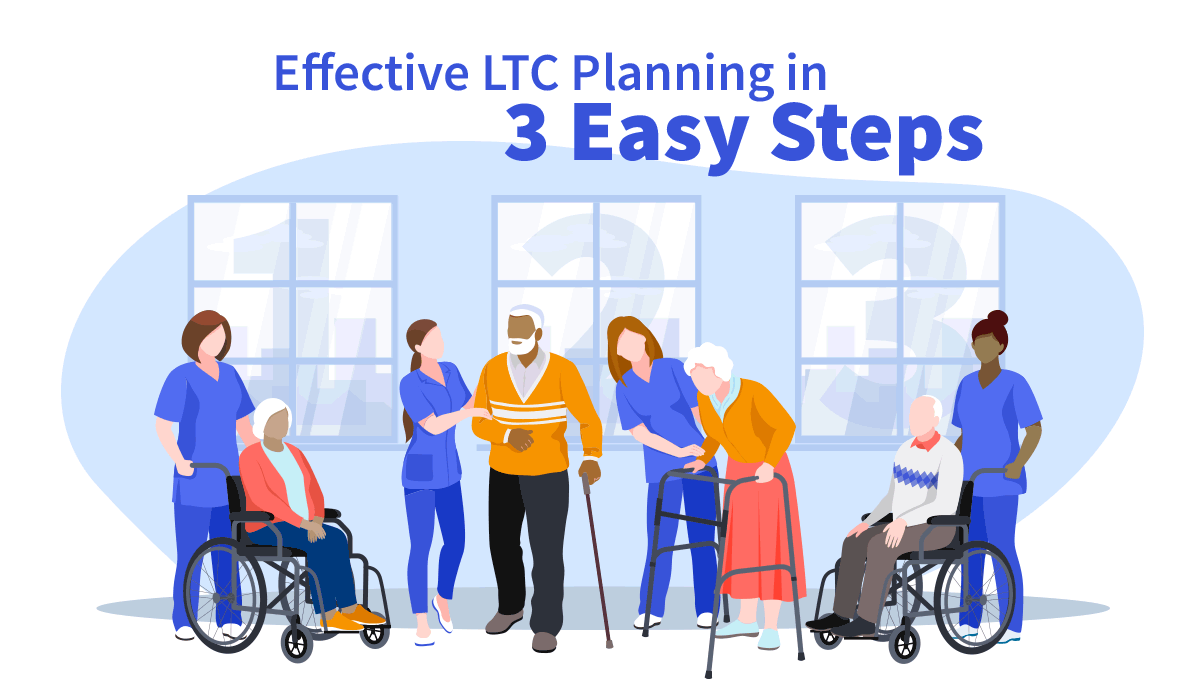Updated September 6, 2023, at 9:46 PM
The long-term care (LTC) insurance product landscape has changed dramatically over the past decade. Today, consumers have more options than ever, including asset-based LTC.
LTC insurance has its advantages and the process needed to become an effective care planner can be simple enough for you to repeat over and over without skipping a beat.
LTC Insurance
LTC with a life insurance or annuity chassis is one of the more popular options and a good fit to help your clients meet their planning objectives. The three-step process that I outline below can serve as a tool to help you work with clients that match the needs for an asset-based LTC policy.
Advantages
Asset-based products offer many advantages to consumers that traditional LTC insurance products don’t. These include day-one return of premium, no “use it or lose it” risk, tax-free benefits (living and death), no future rate increases, and flexibility in contributions and benefits.
They also provide clients and financial professionals an opportunity to create a plan that’s priority-driven and supported by contributions from asset re-allocation or cash flow.
The Process
If you’ve previously sold traditional LTC or are new to care planning, how can you become proficient in making product recommendations in today’s robust landscape?
Developing a simple, repeatable, and product-agnostic process to use with every client along with utilizing FIG’s Care Planning Division will lead to full care planning implementation in your practice. Not only will you provide care protection, but you’ll also generate a new revenue stream. Learn more reasons why care planning is vital to a financial professional’s business.
Understanding the Consequences
For Financial Advisors
It’s important to understand the financial, emotional, and physical consequences clients and their families could face if they don’t have an effective LTC plan. One helpful resource to prepare you for this is The Conversation by Harley Gordon.
This book outlines:
- The consequences of not having an LTC plan
- How to ask the right questions for an effective client conversation
- How to move the process toward identifying appropriate solutions within the financial plan to mitigate risk
For Clients
Gordon recommends the LTC conversation should always lead with the consequences an extended care event can have on the client’s family before addressing risks to the individual. Once the consequences are understood, help clients understand the financial impact a care planning event can have on their assets.
You can show them the current and future costs of care in their area using Genworth’s Cost of Care Survey, which is also the source cited on the US government’s LTC website (for added credibility).
We recommend printing the PDF report for your client meeting. We also recommend mailing them a long-term care myths piece a week before the scheduled appointment to start getting them in the right mindset before the meeting.
Related: 7 Annuity Myths (And the Truths Behind Them)
3-Step Planning Strategy
Step 1: Asset Identifier
“Mr. and Mrs. Client, if something were to happen to you today that required some or a significant amount of assistance to allow you to continue to live in your home, what asset would you access first to pay for care?”
The Asset Identifier is where you find the money. Present this as doing your due diligence given the financial impact LTC has on portfolios. If a care event happens, you need to be able to advise the family on where to start pulling assets from first. Simply fill in the costs based on the previously pulled Genworth Cost of Care report. Let clients know this form will continue to be assessed annually during reviews to ensure accuracy in their preferences.
During this conversation, you may find assets you weren’t aware of before. Once the preferred asset has been identified, say something like, “What I’d like to do is add efficiencies to your plan.”
This leads to presenting care planning solutions leveraging asset-based LTC products.
Sources to Fund LTC
Asset-based LTC products accept funds from a wide range of sources to accommodate planning objectives. Making a suitable product recommendation requires an assessment of a client’s insurance holdings, assets within portfolios, and cash flow or income plans.
Cash or Cash Equivalent
Use dead assets or assets your clients set aside for rainy day funds–or those they aren’t using for income.
Cash Value Life Insurance
An insurance review is a great place to start looking for sources of funding. Our Comprehensive Analysis and Review (CAR) program can do this for you on any in-force permanent life policy. It’s important to review a client’s in-force insurance plan as a potential source of funding (cash value).
In addition, some life insurance products contain living benefits including critical, chronic, and terminal illnesses. Some annuities contain provisions for LTC needs, as well.
Annuities
The Pension Protection Act (PPA) authorizes the transfer into PPA-compliant LTC annuities for triple tax efficiencies:
- Tax-free transfer
- Tax-free deferral
- Tax-free distribution for LTC benefits
Most carriers with LTC annuities will offer additional leverage to increase the benefit pool. This option is great for highly appreciated annuities.
RMD Strategies & Qualified Savings
Using RMD strategies to fund LTC insurance plans is common among financially-stable retirees who recognize they’re not dependent on any or all of their qualified savings to support their lifestyle.
Income
Leveraging an LTC strategy with current or future cash flow can be a viable alternative. An LTC plan designed with systematic contributions is a helpful method to fund traditional plans.
Related: Long-Term Care for Younger Clients
Step 2: The 50/10 Strategy
Once the client has identified the asset earmarked for a potential care event, ask if you can add efficiencies to their plan. You can consult with the FIG Care Planning Divison to make the best recommendation for the client.
The care planning conversation should never lead with premium talk. Instead, focus on the cost of care and monthly benefit levels using the 50/10 Strategy:
50: Solve for 50% of the high-end costs (nursing home) which covers close to 100% of the low-end costs (home care).
10: Show a ten-pay solution first. Clients don’t want to think about writing a single-premium check. To address that objection upfront, we suggest saying, “We’ve designed this solution as a starting point to cover 50% of the high-end risk, paying for it over a ten-year period. We want to make it as easy as possible for you from a cash flow standpoint. However, there are other ways we can fund this if you prefer.”
We also suggest you show the single premium amount for how much paying over ten years will costs. Consider saying something like, “Paying over ten years costs ‘X’ amount. However, if you want to keep the benefits exactly the same and pay in a shorter period, you’ll see that there’s a discount for paying in bulk, saving you ‘X’ amount in total.”
Be sure to reiterate, “Mr. and Mrs. Client, understand that these numbers are just a starting point to show you what a 50% hedge against the high-end risks looks like. As we’ve discussed, this can be customized to what you’re comfortable with so we can go up or down from here to find the appropriate solution for you.”
Here, it’s important to communicate with your clients how their assets are exposed to the financial risk inherent to the aging process. Re-state the consequences of this financial risk and demonstrate how the care planning recommendation will add efficiencies to their plan identified on the Asset Identifier.
The plan will be funded by recognizing their priorities. This approach helps you make a recommendation without pushing a sales pitch.
Step 3: Identify Care Planning Opportunities
Lastly, it’s critical to know your sources. It not only makes the process faster and easier, but it shows your clients that you’re an expert that can be trusted with their hard-earned assets.
Funding sources may include:
- Cash or cash equivalents
- Re-positioning cash value life insurance or annuities
- Qualified assets
- Income
Comb through your book of business and set appointments to discuss care planning. We even have a product-agnostic pre-approach letter script that you can use.
Last Point
Review older insurance policies to see if they provide living benefits, are outdated, or underperforming.
These policies enable agents to leverage account values and plan contributions to implement a care planning solution. Our CAR program is available to all FIG agents for a free, comprehensive analysis and review on any permanent, in-force life insurance policy to assess whether the policy is in good standing or whether present efficiencies as appropriate.


